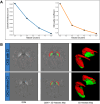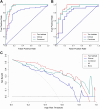Habitat analysis of iron deposition in the basal ganglia for diagnosing cognitive impairment in chronic kidney disease: evidence from a case-control study
- PMID: 40200199
- PMCID: PMC11980340
- DOI: 10.1186/s12880-025-01656-7
Habitat analysis of iron deposition in the basal ganglia for diagnosing cognitive impairment in chronic kidney disease: evidence from a case-control study
Abstract
Background: Chronic kidney disease induces alterations in the heterogeneity of iron deposition within the basal ganglia. Quantitative analysis of the heterogeneity of iron deposition within the basal ganglia may be valuable for diagnosing chronic kidney disease-related cognitive impairment.
Methods: In this prospective observational cohort study, quantitative susceptibility mapping (QSM) was performed in chronic kidney disease patients. Susceptibility values of each nucleus within the basal ganglia were measured. Radiomic features were extracted from habitats of the basal ganglia on QSM images. Habitat-based models for diagnosing cognitive impairment were constructed using the random forest algorithm. Logistic regression was employed to build the clinical model and the combined model. The performance of each model was evaluated by the receiver operating characteristic (ROC) analysis.
Results: A total of 146 patients (mean age, 51 ± 13 years; 92 male) were included, of which 79 had cognitive impairment. The two habitats-based model achieved an area under the curve of 0.926 (95% CI 0.842-1.000) on the test set, the highest among all prediction models. The two-habitat maps indicated that chronic kidney disease had two distinct patterns of impact on iron deposition in the basal ganglia region. The capability of the two habitats-based model to identify chronic kidney disease-related cognitive impairment was significantly superior to that of the susceptibility values measured in various nuclei (all p < 0.05).
Conclusions: This study innovatively applied a habitat-based quantitative analysis technique to QSM, successfully constructing a model that accurately diagnoses chronic kidney disease-related cognitive impairment.
Trial registration: This study was approved by the Beijing Friendship Hospital Ethics Board (ClinicalTrials.gov Identifier: NCTO5137470) and conducted in accordance with the Declaration of Helsinki ethical standards.
Keywords: Basal ganglia; Chronic kidney disease; Cognitive impairment; Quantitative susceptibility mapping; Radiomics.
© 2025. The Author(s).
Conflict of interest statement
Declarations. Ethics approval and consent to participate: This study was approved by the Beijing Friendship Hospital Ethics Board (ClinicalTrials.gov Identifier: NCTO5137470) and was conducted in accordance with the ethical standards of the Declaration of Helsinki. Written informed consent was obtained from all subjects (patients) prior to participation in the study. Consent for publication: Not applicable. Competing interests: The authors declare no competing interests.
Figures





Similar articles
-
Regional high iron deposition on brain quantitative susceptibility mapping correlates with cognitive decline in chronic kidney disease patients.Brain Imaging Behav. 2025 Apr;19(2):395-406. doi: 10.1007/s11682-025-00976-0. Epub 2025 Feb 11. Brain Imaging Behav. 2025. PMID: 39930019 Free PMC article.
-
Associations of quantitative susceptibility mapping with Alzheimer's disease clinical and imaging markers.Neuroimage. 2021 Jan 1;224:117433. doi: 10.1016/j.neuroimage.2020.117433. Epub 2020 Oct 6. Neuroimage. 2021. PMID: 33035667 Free PMC article.
-
Brain iron deposition and cognitive decline in patients with cerebral small vessel disease : a quantitative susceptibility mapping study.Alzheimers Res Ther. 2025 Jan 9;17(1):17. doi: 10.1186/s13195-024-01638-x. Alzheimers Res Ther. 2025. PMID: 39789638 Free PMC article.
-
Quantitative susceptibility mapping for iron monitoring of multiple subcortical nuclei in type 2 diabetes mellitus: a systematic review and meta-analysis.Front Endocrinol (Lausanne). 2024 Mar 6;15:1331831. doi: 10.3389/fendo.2024.1331831. eCollection 2024. Front Endocrinol (Lausanne). 2024. PMID: 38510699 Free PMC article.
-
Iron quantification in basal ganglia: quantitative susceptibility mapping as a potential biomarker for Alzheimer's disease - a systematic review and meta-analysis.Front Neurosci. 2024 Feb 26;18:1338891. doi: 10.3389/fnins.2024.1338891. eCollection 2024. Front Neurosci. 2024. PMID: 38469572 Free PMC article.
References
-
- Kalantar-Zadeh K, Jafar TH, Nitsch D, Neuen BL, Perkovic V. Chronic kidney disease. Lancet. 2021;398(10302):786–802. - PubMed
-
- Haacke EM, Liu S, Buch S, Zheng W, Wu D, Ye Y. Quantitative susceptibility mapping: current status and future directions. Magn Reson Imaging. 2015;33(1):1–25. - PubMed
-
- Vinayagamani S, Sheelakumari R, Sabarish S, Senthilvelan S, Ros R, Thomas B, et al. Quantitative susceptibility mapping: Technical considerations and clinical applications in neuroimaging. J Magn Reson Imaging: JMRI. 2021;53(1):23–37. - PubMed
Publication types
MeSH terms
Substances
Grants and funding
- 82202099 and 52227814/National Natural Science Foundation of China
- ZYLX201824 and ZYLX202101/Beijing Municipal Administration of Hospitals Clinical Medicine Development of Special Funding Support
- SML20150101/Beijing Municipal Administration of Hospital's Mission Plan
- YYZZ202129, yyqcjh2023-7/Beijing Friendship Hospital, Capital Medical University
- CCMU2022ZKYXY011/Training Fund for Open Projects at Clinical Institutes and Departments of Capital Medical University
LinkOut - more resources
Full Text Sources
Medical

